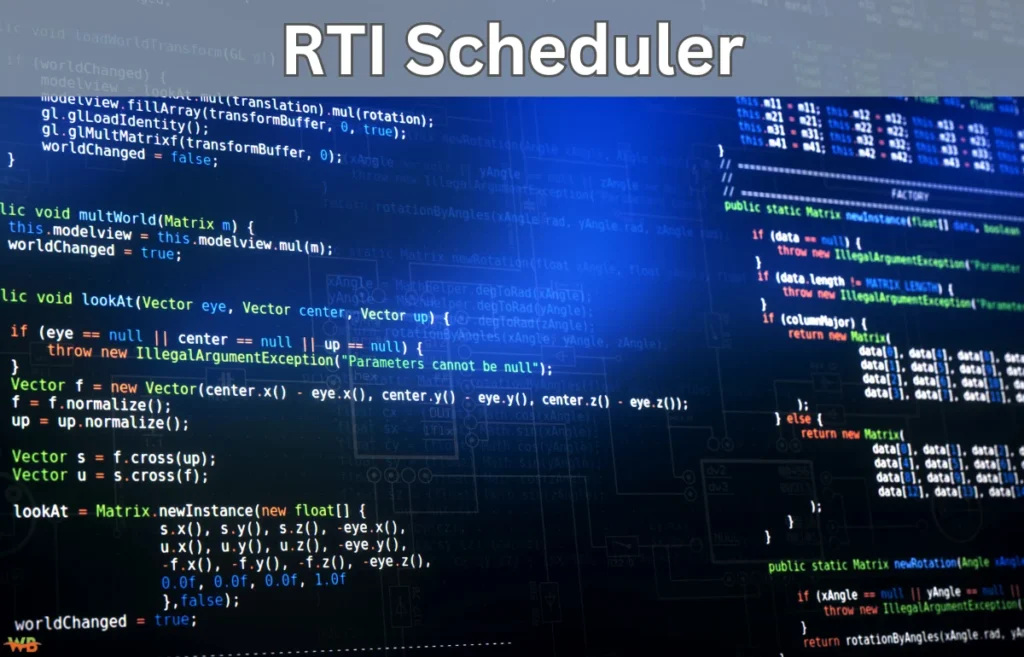In today’s fast-paced technological world, the need for precise and reliable task management in real-time systems is more critical than ever. Enter the RTI Scheduler, a powerful tool designed to ensure that tasks in time-sensitive environments are executed efficiently, on time, and without errors. From robotics to aerospace, RTI Scheduler plays a key role in industries where precise and timely execution of tasks is crucial.
This article will walk you through the features, benefits, and various applications of RTI Scheduler while highlighting how it ensures systems remain reliable, efficient, and capable of meeting stringent deadlines.
Why RTI Scheduler Matters in Real-Time Scheduling
Real-time scheduling is the cornerstone of modern systems that require precise task execution under strict time constraints. Unlike traditional scheduling tools, which often handle tasks based on a general timeline, RTI Scheduler prioritizes tasks dynamically, ensuring that high-priority tasks are executed first.
In real-time systems, delays can have disastrous consequences. For instance, in autonomous vehicles, a delay in processing sensor data could lead to accidents. In medical devices, failing to meet deadlines could jeopardize patient health. This is where RTI Scheduler shines, offering solutions that prioritize time-critical operations across various industries, including:
- Autonomous vehicles processing sensor data.
- Medical devices monitoring vital health parameters.
- Industrial automation systems coordinating complex operations.
By ensuring that the most important tasks are completed on time, RTI Scheduler provides the reliability and precision needed for these high-stakes environments.
Key Features of RTI Scheduler
The RTI Scheduler stands out in its ability to manage real-time tasks seamlessly.
Dynamic Task Prioritization
One of the key features of RTI Scheduler is its ability to dynamically adjust task priorities based on changing system conditions. This ensures that urgent tasks are given higher priority, reducing the risk of delays in mission-critical operations.
Low Latency
When working with time-sensitive applications, even a small delay can cause significant problems. It minimizes latency, ensuring tasks are executed promptly and that critical systems remain responsive at all times.
Scalability
RTI Scheduler accommodates a wide range of task loads, maintaining its reliability and speed as demands increase. It can handle increasing workloads without compromising performance, which is essential for businesses experiencing growth or those expanding their technological capabilities.
Error Handling
No system is immune to errors. RTI Scheduler is equipped with advanced mechanisms to identify and address task failures, ensuring the system remains stable and operational. This ensures that if a task fails or encounters an issue, the system remains stable, and corrective measures are promptly implemented.
Resource Optimization
Benefits of Using RTI Scheduler
When organizations and developers implement RTI Scheduler, they unlock a host of benefits, including:
1. Enhanced Efficiency
By dynamically prioritizing tasks, RTI Scheduler eliminates bottlenecks and ensures that resources are used effectively. This results in improved efficiency, allowing systems to run smoothly without unnecessary delays.
2. Improved Reliability
For systems like healthcare monitors, flight control systems, and autonomous vehicles, reliability is paramount. It ensures that deadlines are met, even in high-pressure environments, helping to guarantee the stability of critical systems.
3. Scalability for Growth
As your business or technology evolves, the system grows with you. Its ability to handle an increasing number of tasks without losing performance makes it ideal for expanding organizations, ensuring that technology remains seamless even as complexity rises.
4. Reduced Development Time
By using pre-built scheduling algorithms and tools, developers can integrate RTI Scheduler into their systems quickly. This reduces development time and lets teams focus on system functionality and innovation, rather than reinventing the wheel for task management.
Applications of RTI Scheduler
The versatility of the RTI Scheduler allows it to be used across a wide range of industries. Here are some notable applications:
Robotics
In robotics, precision and timing are critical. Through advanced scheduling techniques, RTI Scheduler maintains accurate timing for motion control, sensor data management, and synchronization in robotic systems. Whether it’s a manufacturing robot or a robotic arm in a surgical setting, the system ensures everything runs on time.
Automotive Industry
Modern vehicles are increasingly reliant on real-time systems for functions like navigation, collision detection, and autonomous driving. RTI Scheduler optimizes these systems to ensure that safety features, sensor data processing, and decision-making are executed in real-time, enhancing overall vehicle performance.
RTI Scheduler in Telecommunications
Telecommunications rely heavily on real-time data transmission. RTI Scheduler ensures smooth data packet handling and communication, reducing latency and improving connectivity in everything from cellular networks to satellite systems.
Aerospace and Defense
In critical aerospace and defense applications, such as missile guidance or satellite operations, RTI Scheduler guarantees that tasks are executed with unmatched precision. In these high-stakes environments, where lives and national security may be on the line, the dependability of the system cannot be overstated.
How RTI Scheduler Works
The RTI Scheduler utilizes a series of advanced algorithms to manage task scheduling and resource allocation. Here is a condensed, step-by-step explanation of how it behaves:
Step 1: Task Registration
First, tasks are queued within the system. Each task is allocated a priority and a defined time frame for completion. This ensures that the system knows which tasks are most urgent and should be completed first.
Step 2: Resource Allocation
Once tasks are registered, the RTI Scheduler allocates resources (CPU, memory, etc.) based on the priority of each task. Tasks with higher priority levels are given the necessary resources to ensure they are executed without delay.
Step 3: Task Execution and Monitoring
As tasks are executed, the system continuously monitors to detect any potential delays or failures. It ensures that each task is completed as scheduled, and if any issues arise, it can take corrective action.
Step 4: Error Recovery
In the event of a task failure, RTI Scheduler quickly reallocates resources to maintain system stability. Whether it’s adjusting priorities or rerouting tasks, the system ensures that operations continue smoothly.
Why Choose RTI Scheduler for Your Real-Time Systems?
If your business or organization is operating in a field that demands precision, reliability, and scalability, RTI Scheduler is the tool you need. Here’s why:
- Unmatched Precision: In industries where split-second decisions can make the difference, RTI Scheduler ensures that tasks are executed on time and with the highest level of accuracy.
- Proven Reliability: With its robust error handling and real-time monitoring, it guarantees system stability and ensures that critical systems remain operational, even in high-pressure environments.
- Future-Proof Scalability: As your operations grow, the system scales seamlessly, handling an increasing number of tasks without losing performance.
By implementing this tool, you not only improve task management but also ensure that your systems are capable of meeting the demands of tomorrow’s technology.
Conclusion: How RTI Scheduler Optimizes Task Management for Real-Time Systems
Real-time systems are at the core of our digitally connected era, ensuring timely and accurate task execution. Whether you’re working in robotics, automotive, telecommunications, or aerospace, RTI Scheduler offers the advanced features, scalability, and reliability needed to meet the demands of modern technology.
From dynamic task prioritization to low latency and resource optimization, this tool ensures your systems are always operating at peak efficiency, making it an essential solution for any business involved in real-time applications.
By adopting this tool, you’re not just optimizing your task management — you’re securing the future of your systems.
FAQs
1. How does real-time task management improve system performance?
- Real-time task management ensures that critical tasks are executed within specific time constraints, preventing delays and system inefficiencies. By prioritizing tasks based on urgency, it guarantees that essential functions are handled first, optimizing overall system performance.
2. What industries benefit the most from real-time scheduling systems?
- Industries that rely on precise and time-sensitive operations, such as robotics, healthcare, automotive, and aerospace, greatly benefit from real-time scheduling systems. These industries require systems to perform with minimal delay to ensure safety, reliability, and accuracy.
3. Can real-time systems scale as my operations grow?
- Yes, modern real-time scheduling systems are designed to scale effortlessly. As your workload increases, the system can handle more tasks without compromising performance, making it an ideal solution for businesses expecting growth or technological advancements.
4. How does dynamic task prioritization work in time-sensitive environments?
- Dynamic task prioritization adjusts the order in which tasks are executed based on their urgency and deadlines. In time-sensitive environments, this ensures that the most critical tasks are completed first, reducing the risk of delays and system failures.
5. What happens if a task fails during execution in a real-time system?
- If a task encounters an issue, most real-time systems come with built-in error recovery mechanisms. These systems automatically detect failures, reallocate resources, and adjust priorities to maintain stability and ensure other tasks are completed without disruption.

Ton Roobprom is an experienced writer focused on practical advice across technology, business, travel, beauty, lifestyle, and home improvements. He specializes in distilling complex subjects into clear, actionable insights to help you enhance your daily life.


